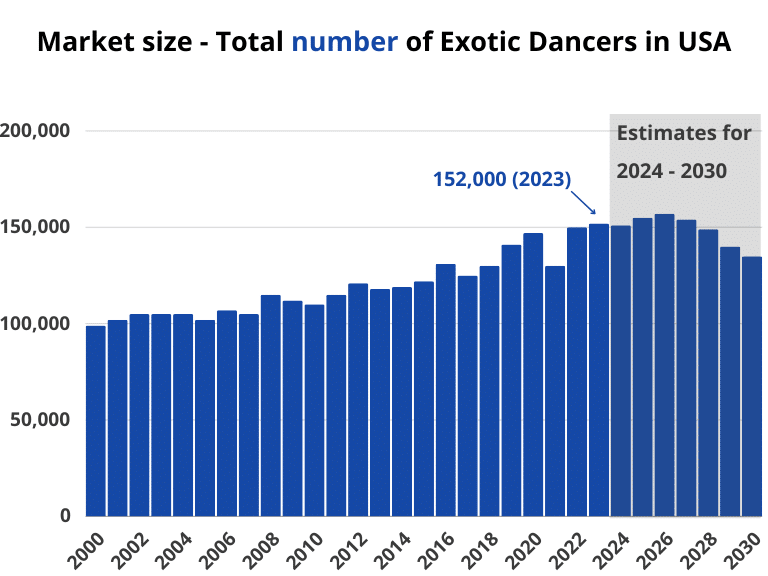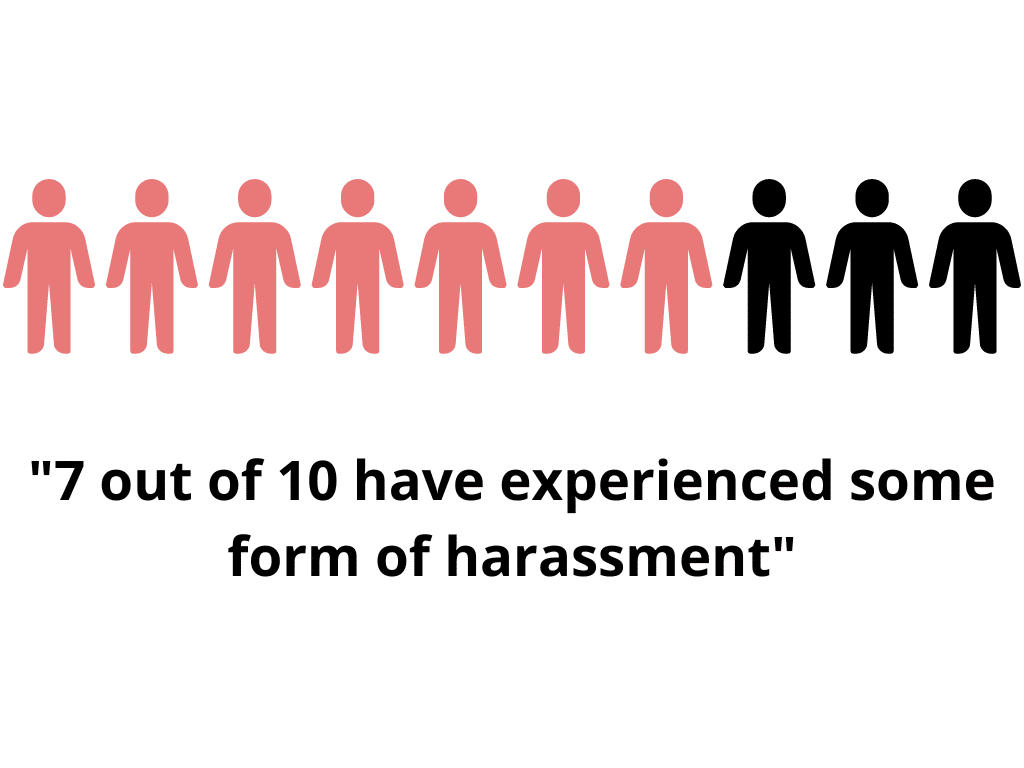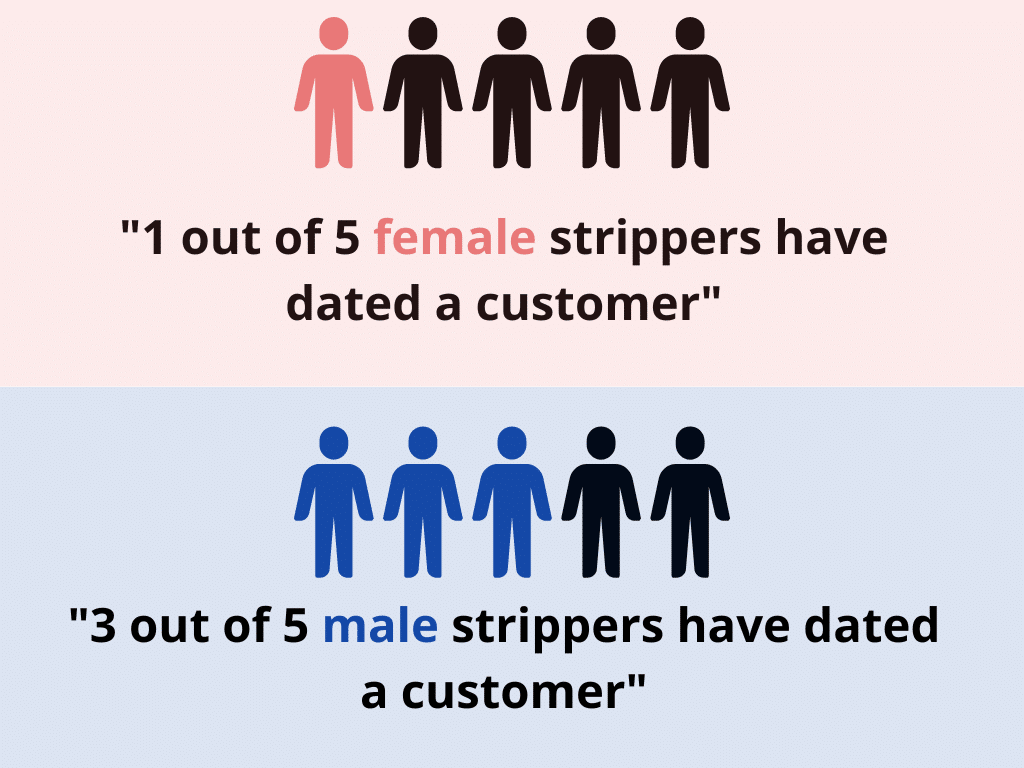![Exotic Dancer Statistics [Facts About Stripping]](https://wp.bedbible.com/wp-content/uploads/2023/03/Exotic-Dancer-Statistics.png)
Venture beyond the glitz and glamour to discover the captivating world of exotic dancing through a revealing statistical lens. This comprehensive piece delves into various aspects of the stripper profession, from earnings and job satisfaction to personal relationships and mental health, offering an insightful glimpse into an industry often obscured by misconceptions and stereotypes.
Here’s what we’ve covered:
- General insights
- Job Satisfaction
- Exotic Dancer Salary
- Work & Education
- Family Dynamics
- Becoming a Stripper
- Strippers and Prostitution
- Health & Psychological effects of stripping
Key Takeaways
- Market Size: Estimations Reveal 152,000 Exotic Dancers in the US, Surpassing 450,000 Globally.
- The average hourly pay is 20$.
Part-time exotic dancers: $25,000 – $50,000 per year.
Full-time exotic dancers: $60,000 – $100,000+ per year. - 80-90% of strippers are females, and only 10-20% are males.
- 23 years old is the average age for an exotic dancer.
- 50-60% of exotic dancers work part-time, averaging 20-30 hours per week.
- 60-75% of exotic dancers experience some form of harassment, leading to reduced job satisfaction.
- Tips and customer gratuities account for 20-30% of the income received.
- 60-70% of exotic dancers have completed high school.
- Around 3 out of 10 exotic dancers move on to different roles within the adult entertainment industry, including club management or event planning.
- 6 out of 10 strippers are in a relationship.
- 10% of strippers are married.
- 1 out of 5 female strippers have dated a customer.
3 out of 5 male strippers have dated a customer. - 10-15% of exotic dancers report having engaged in prostitution at some point during their dancing careers.
- 60-70% of exotic dancers report improved physical fitness, flexibility, and muscle tone due to their work.
- 60-70% of dancers experience work-related stress, which can contribute to anxiety, depression, and substance abuse.
General insights
- Market Size:
- There are approximately 150,000 exotic dancers in the United States and over 450,000 worldwide.
- Gender Representation:
- Female dancers: 80-90% of exotic dancers are female.
- Male dancers: 10-20% of exotic dancers are male, often performing in specialized venues or events.
- Age Range:
- The majority of exotic dancers fall within the age range of 18-35 years old, with the average age being around 24 years old.
- 6% of strippers have worked in the niche for more than 20 years.
- 23 years old is the average age for a stripper.
- Working Hours:
- Part-time dancers: 50-60% of exotic dancers work part-time, averaging 20-30 hours per week.
- Full-time dancers: 40-50% of exotic dancers work full-time, averaging 30-40 hours per week.

Job Satisfaction in the Exotic Dancer Industry
The exotic dancer profession elicits a wide range of experiences and emotions, making job satisfaction a complex and multifaceted issue. In this section, we present statistics that delve into the various factors that contribute to job satisfaction for those working in the exotic dancing industry. By examining aspects such as earnings, working conditions, personal fulfillment, and challenges faced by dancers, we provide a comprehensive understanding of the factors that shape the overall job satisfaction of exotic dancers. Join us as we explore the numbers that reveal the diverse experiences and perspectives of individuals in this captivating profession.
- Positive Aspects:
- Flexible work schedule: 60-70% of dancers report valuing the ability to choose their hours and workdays.
- Earning potential: 65-75% of exotic dancers appreciate the opportunity for potentially high earnings.
- Social interaction: Approximately 50% of dancers cite the social aspect of their job as a significant contributor to job satisfaction.
- Empowerment: 40-50% of exotic dancers report feeling empowered and confident due to their work.
- Negative Aspects:
- Inconsistent income: 70-80% of dancers report that income instability can negatively impact job satisfaction.
- Harassment and safety concerns: 60-75% of exotic dancers experience some form of harassment, leading to reduced job satisfaction.
- Stigma: Approximately 65% of dancers report that societal stigma and judgment negatively affect their job satisfaction.
- Working conditions: 50-60% of dancers cite poor working conditions, such as long hours and lack of benefits, as detrimental to their job satisfaction.
- Overall Satisfaction:
- Mixed experiences: While some dancers report high job satisfaction due to factors such as earnings, flexibility, and personal fulfillment, others experience reduced satisfaction due to negative aspects like harassment, stigma, and inconsistent income.
- 55% of exotic dancers report moderate to high levels of job satisfaction, while 45% report low to moderate satisfaction levels.

Exotic Dancer Salary
Earnings in the exotic dancing industry can vary significantly, influenced by factors such as location, club type, clientele, and individual performance. In this section, we present statistics that provide a detailed look into the range of salaries and income sources associated with a career as an exotic dancer. By examining the nuances of earning potential, we offer a comprehensive understanding of the financial aspects of this profession. Join us as we delve into the numbers that reveal the intricacies of exotic dancer salaries and the factors that contribute to their fluctuating nature.
- Earnings per night:
- Entry-Level: $100 – $300 per night, typically at smaller clubs with limited experience.
- Mid-Level: $300 – $800 per night, often working in mid-sized clubs with some experience.
- Experienced: $800 – $1,500 per night, commonly performing at larger clubs and in high demand.
- High-End Performers: $1,500 – $5,000+ per night, usually at upscale clubs and with celebrity status.
- The average hourly pay is 20$
- Annual earnings:
- Part-time exotic dancers: $25,000 – $50,000 per year.
- Full-time exotic dancers: $60,000 – $100,000+ per year.
- Income sources:
- Dance fees: 60-70% of income comes from stage and private dances.
- Tips: 20-30% of income is derived from tips and customer gratuities.
- Ancillary services: 10-15% of income can be generated from activities such as drink sales, hosting events, or online content creation.
- Factors influencing earnings:
- Location: Dancers in major cities or tourist destinations typically earn more than those in smaller towns or rural areas.
- Club reputation: Upscale clubs and those with a higher customer base can offer increased earning potential.
- Personal brand: Building a loyal clientele and maintaining a strong online presence can positively impact earnings.
| Level | Average Earnings Per Night | Factors Influencing Earnings |
|---|---|---|
| Entry-Level | $100 – $300 | Smaller clubs, limited experience |
| Mid-Level | $300 – $800 | Mid-sized clubs, some experience |
| Experienced | $800 – $1,500 | Larger clubs, high demand, private |
| High-End Performers | $1,500 – $5,000+ | Upscale clubs, celebrity status |
Work & Education: Balancing Professional Life as a Stripper
Unique intersections between work, education, and personal development often characterize the exotic dancing profession. In this section, we present statistics that delve into the intricate relationship between being a stripper and pursuing educational goals or other career paths. By examining the diversity of educational backgrounds, parallel careers, and skillsets of exotic dancers, we offer a comprehensive understanding of the multidimensional aspects of life as a stripper. Join us as we explore the numbers that illuminate the various pathways and opportunities for those working in the exotic dancing industry.
- Educational Background:
- High school diploma or equivalent: 60-70% of exotic dancers have completed high school.
- Some college education: 40-50% of exotic dancers have attended college but may not have completed a degree.
- College degree: 25-35% of exotic dancers hold a college degree, with fields ranging from liberal arts to STEM subjects.
- Balancing Work and Education:
- 50-60% of exotic dancers report working while pursuing a degree, using exotic dancing as a means to support their education.
- 40-50% of exotic dancers use their earnings from dancing to pay off student loans or fund continuing education.
- Parallel Careers and Skillsets:
- 30-40% of exotic dancers hold a part-time or full-time job in addition to their dancing career.
- Common parallel careers include retail, service industry, healthcare, and creative professions.
- Exotic dancers often develop valuable transferable skills such as sales, customer service, negotiation, and communication.
- Transitioning to Other Professions:
- 20-30% of exotic dancers transition to other careers within the adult entertainment industry, such as club management or event planning.
- 40-50% of exotic dancers move on to careers unrelated to the adult entertainment industry, utilizing their education and skillsets in various fields.
Family Dynamics and the Exotic Dancing Profession
The choice to become an exotic dancer often comes with implications that extend beyond the workplace and into the realm of personal relationships. In this section, we present statistics that reveal how family dynamics may be affected by a career in the exotic dancing industry. By examining the impact on romantic partnerships, parenting, and familial relationships, we provide a comprehensive understanding of exotic dancers’ challenges and triumphs as they navigate their professional and personal lives. Join us as we explore the numbers that shed light on the delicate balance of family life in the world of exotic dancing.
- Romantic Relationships:
- 50-60% of exotic dancers report being in a committed romantic relationship.
- Relationship challenges: 40-50% of exotic dancers report facing issues such as jealousy, trust, and communication difficulties in their romantic relationships due to their profession.
- 10% of strippers are married.
- 1 out of 5 female strippers have dated a customer.
- 3 out of 5 male strippers have dated a customer.
- Parenting:
- 30-40% of exotic dancers have children.
- Balancing work and family: 60-70% of exotic dancers who are parents report using their flexible work schedule to manage childcare responsibilities.
- Around 90% of strippers come from a religious background
- Familial Relationships:
- Family support: Approximately 40-50% of exotic dancers report receiving support from their family members regarding their profession.
- Stigma and strained relationships: 30-40% of exotic dancers experience strained relationships with family members due to the nature of their work.
- Social Support:
- 65-75% of exotic dancers report having a strong support system, either through friends or family members, that helps them navigate the challenges of their profession.
- Exotic dancer community: Many dancers develop friendships and supportive connections within the industry, with 50-60% of dancers reporting a sense of camaraderie with their colleagues.

Becoming a Stripper: Key Steps and Statistics
Embarking on a career in exotic dancing requires knowledge, preparation, and a clear understanding of the industry’s realities. In this section, we present statistics and essential steps for those interested in becoming a stripper, providing insights into the skills, background, and networking opportunities that can contribute to success in the profession. Join us as we explore the numbers behind the journey of entering the world of exotic dancing, offering a roadmap for aspiring performers to navigate this unique and captivating career path.
- Auditions and Training:
- 80-90% of exotic dancers begin their careers by auditioning at a club.
- 50-60% of exotic dancers receive on-the-job training from more experienced dancers or club staff.
- 20-30% of dancers attend formal dance classes, such as pole dancing, to enhance their skills.
- Networking and Building a Clientele:
- 60-70% of exotic dancers report that building a loyal clientele is crucial for long-term success.
- 40-50% of dancers use social media to promote themselves and connect with clients.
- Licenses and Permits:
- Depending on the location, 30-40% of exotic dancers are required to obtain an adult entertainer license or permit to work legally.
- Club Types and Opportunities:
- Variety in club types: Approximately 70% of exotic dancers work in a mix of urban and rural clubs, upscale venues, and neighborhood establishments.
- Club employee vs. Independent contractor: 60-70% of exotic dancers work as independent contractors, while 30-40% are classified as employees, which can impact job stability and benefits.
- Transitioning from Amateur to Professional:
- 50-60% of exotic dancers report a learning curve when transitioning from amateur to professional, with increased emphasis on performance quality, customer interaction, and stage presence.
Strippers and Prostitution: Unraveling the Connection
The adult entertainment industry is vast and multifaceted, encompassing various professions that often intertwine or exist within proximity. In this section, we present statistics and data that explore the relationship between exotic dancers and prostitution. By examining the potential overlap, misconceptions, and unique challenges faced by professionals in both fields, we aim to shed light on the distinctions and similarities between these two professions. Join us as we delve into the numbers to better understand the complex dynamics within the adult entertainment industry.
- Distinct Professions:
- Exotic dancing primarily focuses on performance and entertainment, while prostitution involves the direct exchange of sexual services for money. It is crucial to differentiate between the two professions.
- Misconceptions:
- 60-70% of the general public believe there is a strong connection between exotic dancing and prostitution, often due to misinformation and societal stigma.
- Involvement in Prostitution:
- Studies show that 10-15% of exotic dancers report having engaged in prostitution at some point during their dancing careers. However, it is crucial to note that the majority of exotic dancers do not engage in prostitution.
- Among those who do engage in prostitution, reasons may include financial necessity, coercion, or personal choice.
- Club Policies and Regulations:
- The majority of strip clubs (approximately 80-90%) have strict policies against prostitution and maintain a clear separation between exotic dancing and prostitution.
- Violation of these policies often results in termination of employment or legal consequences.
- Legal and Social Implications:
- In many countries, prostitution is illegal, while exotic dancing is a legal profession, further emphasizing the distinction between the two.
Health & Psychological effects of stripping
A comprehensive understanding of the exotic dancing profession necessitates an exploration of its impact on the health and psychological well-being of those who choose this career path. In this section, we present statistics that reveal the intricate relationship between the physical demands of performing and the emotional challenges faced by exotic dancers. By examining both the potential risks and the positive aspects of this profession, we provide a balanced view of the effects of stripping on mental and physical health. So, let’s delve deeper into the numbers and gain a more nuanced perspective on the realities of the exotic dancing industry.
- Physical Health:
- Positive effects: 60-70% of exotic dancers report improved physical fitness, flexibility, and muscle tone due to their work.
- Negative effects: 40-50% of dancers experience work-related injuries, such as strains and sprains, as well as long-term issues, such as back pain and joint problems.
- Mental Health:
- Positive effects: 40-50% of exotic dancers report increased self-confidence and empowerment resulting from their profession.
- Negative effects: 60-70% of dancers experience work-related stress, which can contribute to anxiety, depression, and substance abuse.
- Body Image and Self-esteem:
- 50-60% of exotic dancers report having a positive body image, while 30-40% experience body image issues and insecurity.
- Substance Abuse:
- 30-40% of exotic dancers report struggling with substance abuse, often due to the environment, stress, and peer influence.
- Burnout and Coping Mechanisms:
- 50-60% of exotic dancers report experiencing burnout and emotional exhaustion, often resulting from the demands of the job and the need to maintain a work-life balance.
- Common coping mechanisms include seeking social support, engaging in self-care activities, and setting boundaries between work and personal life.
Data and methodology
In this section, we outline the data sources and methodology used to gather the facts and figures presented in our statistical piece on exotic dancing.
Data Sources
- Academic research and publications: To provide a reliable and well-rounded understanding of the industry, we have drawn from various academic studies, journal articles, and research papers that analyze the exotic dancing profession also known as strippers, and its numerous dimensions.
- Industry reports and news articles: By examining reports and articles from reputable sources, we gathered up-to-date information on the latest trends and developments within the exotic dancing industry.
- Surveys and interviews: To gain insights into the personal experiences of exotic dancers, we have referenced surveys and interviews conducted with professionals in the field.
Methodology
- Literature review: A thorough review of the available literature was conducted to identify key themes, statistics, and findings relevant to the exotic dancing industry.
- Data synthesis: The data collected from various sources were synthesized to provide a coherent and comprehensive picture of the industry. This process involved identifying patterns and trends, as well as highlighting any discrepancies or limitations in the available data.
- Presentation of findings: The synthesized data was organized into sections and punctuated lists to provide a clear and concise presentation of the facts and figures.
